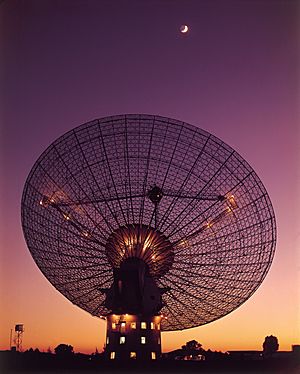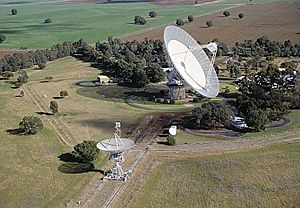Parkes Observatory facts for kids
| Location | Parkes, New South Wales, Australia |
|---|
The Parkes Observatory is a famous radio telescope located about 20 kilometers (12 miles) north of Parkes, New South Wales, Australia. Many people call it "The Dish" because of its giant, round shape. It's one of the most important scientific tools ever built in Australia.
This observatory helped receive the first live TV pictures of the Apollo 11 Moon landing. It has made many amazing discoveries about space over the years.
The Parkes Observatory is run by the Commonwealth Scientific and Industrial Research Organisation (CSIRO). It often works with other CSIRO radio telescopes, like those at the Australia Telescope Compact Array near Narrabri and a single dish at Mopra Observatory. Together, they form a huge network to study the universe.
The observatory was added to the Australian National Heritage List on August 10, 2020, showing how important it is.
Contents
Building "The Dish"
The Parkes Radio Telescope was finished in 1961. It was the idea of Edward George Bowen, who led CSIRO's Radiophysics Laboratory. During World War II, he worked on radar and made friends with scientists in the United States.
He convinced two groups, the Carnegie Corporation and the Rockefeller Foundation, to pay for half of the telescope. This support from the U.S. helped persuade Australia's prime minister, Robert Menzies, to fund the rest of the project.
The Parkes area was chosen in 1956 because it was easy to get to. It was also far enough from Sydney to have clear skies for observations. The local mayor and landowner were also very excited about the project.
The Parkes telescope was so successful that NASA copied its basic design for their own Deep Space Network. They built similar 64-meter (210-foot) dishes in California, Spain, and near Canberra in Australia.
The Parkes telescope is still being improved today. As of 2018, it is 10,000 times more sensitive than when it first started!
How the Radio Telescope Works
The Giant Dish
The main part of the observatory is the huge 64-meter (210-foot) movable dish telescope. It's the second largest movable dish in the Southern Hemisphere.
The inner part of the dish is solid metal, and the outer part is a fine metal mesh. This gives it a unique two-tone look. Over the years, parts of the dish have been upgraded to make it even better at catching signals.
The telescope can move up and down and side to side. It uses a special laser system to follow objects in space very accurately.
Catching Signals from Space
At the center of the dish, 27 meters (89 feet) above it, is a special cabin. This cabin holds many different detectors that can pick up radio and microwave signals from space.
These detectors are very sensitive. Some are cooled to extremely cold temperatures, like -255 degrees Celsius (-427 degrees Fahrenheit), to reduce noise. This allows astronomers to study different kinds of signals and even work on several projects at once.
The Smaller "Kennedy Dish"
The 18-meter (59-foot) "Kennedy Dish" antenna was moved to Parkes in 1963. It was used with the main dish to get more detailed information about objects in space.
This smaller dish was also used to send signals up to spacecraft during the Apollo missions. The main Parkes telescope can only receive signals, not send them.
Working with Other Telescopes
The Parkes Observatory is part of the Australia Telescope National Facility. The 64-meter dish often works with other telescopes in Australia and even from New Zealand, South Africa, and Asia. When they work together, they form a giant "virtual" telescope that can see incredibly fine details in space. This technique is called Very Long Baseline Interferometry (VLBI).
Discoveries and Research
Since it began operating in 1961, the Parkes telescope has made many important discoveries.
- In the 1960s, it helped find the exact location of a strange object called 3C 273. This led to the discovery of "quasars," which are super bright objects powered by black holes.
- It has completed several large surveys of the southern sky, mapping thousands of radio sources.
- More than half of all known pulsars (spinning neutron stars that send out beams of radio waves) were discovered by the Parkes Observatory.
- It is a key part of a program to detect gravity waves, which are ripples in space and time.
The Mystery of Perytons
In 1998, the Parkes telescope started picking up strange signals called "perytons." For a while, scientists wondered if they were signals from other galaxies or something else from space.
However, in 2015, scientists figured out the mystery! Perytons were caused by staff members opening the door of the observatory's microwave oven too early while it was running. When the door was opened, tiny microwave signals would escape and be picked up by the super-sensitive telescope.
Searching for Alien Life
The Parkes telescope is also part of a big project called Breakthrough Listen. This project uses powerful telescopes to search for radio signals from possible alien technologies in space. Parkes helps by scanning parts of our own Milky Way galaxy and looking at nearby stars.
Parkes and Space Missions

The Parkes Observatory has played a big role in tracking many space missions, not just for astronomy research.
During the Apollo program missions to the Moon, Parkes helped relay communication and data to NASA. It was especially important when the Moon was on Australia's side of Earth.
The telescope also helped with NASA's Galileo mission to Jupiter. It even tracked missions like Mariner 2, Mariner 4, Giotto, and Cassini-Huygens.
The Apollo 11 Broadcast
When Buzz Aldrin turned on the TV camera on the Lunar Module during the Moon landing, three antennas received the signals. These were the Goldstone antenna in California, the Honeysuckle Creek antenna near Canberra, and the Parkes dish.
Because the spacewalk started early, the Moon was very low on the horizon for Parkes. Even though they picked up a signal, the first pictures of Neil Armstrong's first steps were broadcast from Honeysuckle Creek.
About nine minutes into the broadcast, the Moon rose higher. The Parkes signal became much clearer and better quality. NASA then switched to the Parkes signal for the rest of the 2.5-hour broadcast.
During the landing, strong winds over 100 kilometers per hour (62 mph) hit the Parkes telescope. The telescope had to operate outside its normal safety limits to keep tracking the Moon!
Mars Rovers
In 2012, the observatory received special signals from the Mars rover Opportunity. This helped prepare for the landing of the Curiosity rover on Mars in August 2012.
Visiting the Observatory
The Parkes Observatory has a Visitors Centre where people can watch the giant dish move. There are also exhibits about the telescope's history, astronomy, and space science. You can even watch a 3-D movie!
Legacy and Culture
In 1995, the Parkes radio telescope was named a National Engineering Landmark. This recognized its importance as the largest radio telescope in the Southern Hemisphere, its clever design, and its many scientific discoveries.
On October 31, 2011, Google Australia changed its logo to a special Google Doodle to celebrate the Parkes Observatory's 50th anniversary.
The Parkes Radio Telescope was added to the National Heritage List in 2020, showing its lasting importance to Australia.
In Movies and Music
- In 1964, the telescope appeared in the opening of The Stranger, Australia's first sci-fi TV series. Some scenes were also filmed at the observatory.
- The observatory and telescope were featured in the 2000 film The Dish. This movie tells a fun, fictional story about the observatory's role in the Apollo 11 Moon landing.
- The telescope is on the cover of Steve Hillage's 1977 album Motivation Radio.
Wiradjuri Names
In November 2020, during NAIDOC Week, the Observatory's three telescopes were given Wiradjuri names. The main telescope ("The Dish") is now called Murriyang. This name comes from the home in the stars of Biyaami, the creator spirit in Aboriginal culture.
The smaller 12-meter dish built in 2008 is named Giyalung Miil, which means "Smart Eye." The third, older antenna is called Giyalung Guluman, meaning "Smart Dish."
Images for kids
See also
 In Spanish: Observatorio Parkes para niños
In Spanish: Observatorio Parkes para niños






